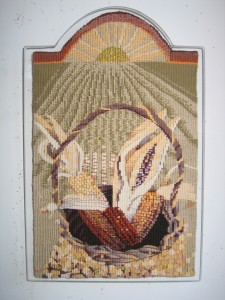
Artist: Jackie Wollenberg
On February 4, 2009 our exhibition “Sin maiz no hay pais” or Sin maiz no hay tapiz (without corn there is no tapestry) opened at the Naval Marine Museo on the Malecon in Puerto Vallarta. Based on last year’s theme of corn at our retreat in El Tuito, tapestries telling stories about corn were presented by our weaving group. The photos will show you what we were up to….corn is the sustenance of the people of Mexico, whether it be food for their stomachs or fuel for their souls. Monsanto wants to have the Mexicans use its GMO seeds in their corn fields. This protest has been going on for a few years — with riots and protesters marching in Mexico City. This was our small way of supporting the Mexicans in their plight to remain in control of their corn seeds, their food and their way of life. A quote from the Museum of Anthropology in Mexico City sums it up well: Maize is the foundation of rural life, and therefore, of the culture of Mexicans, as an axis of the productive economy, as an organizer of time and space, as an essential and irreplaceable element in cooking, as a raw material in many crafts and finally as the center and guide for knowledge accumulated over millenia that is constantly enriched.













